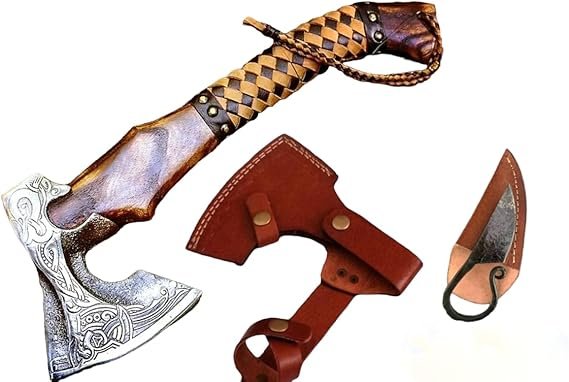
Introduction
Viking axes, steeped in history and legend, are not just remnants of a bygone era but are durable and powerful tools that continue to captivate the imagination of enthusiasts, collectors, and modern-day craftsmen. Known for their effectiveness in combat and their utility in daily tasks, these axes symbolize the strength and resilience of the Viking culture. This article explores the fascinating world of Viking axes, from their historical origins to their contemporary significance, and offers insights into their design, manufacturing, and care.
The History of Viking Axes
Origins and Evolution
Viking axes trace their roots back to the early medieval period, around 800 to 1100 AD, during the height of the Viking Age. Initially, axes were simple tools used for chopping wood and other tasks. As the Vikings evolved into a seafaring and raiding society, the axe’s design adapted for combat. The transition from a utilitarian tool to a formidable weapon marked a significant evolution in its history.
Cultural Significance
Axes held more than practical value for Vikings; they were symbols of power and status. Warriors often carried intricately designed axes into battle, showcasing their craftsmanship and artistic expression. Furthermore, axes were also used in ceremonies and rituals, further embedding them into the cultural fabric of Viking life. They were not merely weapons but tools that represented the Viking ethos of strength, exploration, and survival.
Types of Viking Axes
Battle Axes
Battle axes, designed for warfare, feature broad blades and often come with a longer handle to provide better leverage. These axes were capable of delivering devastating blows to opponents, making them a preferred choice in Viking raids and battles. The head of the battle axe was often crafted for maximum sharpness and weight distribution, allowing for effective strikes.
Working Axes
In contrast to battle axes, working axes were designed for practical tasks such as chopping wood, clearing land, and crafting tools. These axes typically have a more straightforward design, focusing on functionality. The blades of working axes are often thicker and sturdier, suitable for heavy-duty tasks without the need for a razor-sharp edge.
Ceremonial Axes
Ceremonial axes served symbolic purposes and were often elaborately decorated. They were not meant for practical use but were crafted for display in rituals, ceremonies, or as gifts. The artistry involved in making these axes reflects the importance of craftsmanship in Viking culture.
Design Features of Viking Axes
Materials Used
Viking axes were predominantly made from iron, which was both durable and readily available. The heads were often forged from iron, while the handles were made from sturdy woods such as ash or oak. These materials contributed to the axe’s overall strength and longevity, ensuring that they could withstand rigorous use.
Blade Design
The blade design of Viking axes varies according to their intended use. Battle axes often feature a tapered, sharp edge for piercing, while working axes have broader blades for effective chopping. Some axes have unique blade shapes, like the bearded axe, which offers increased control and versatility during use.
Handle Construction
The handle, or haft, of a Viking axe is crucial for its performance. Typically around 3 to 4 feet long, the handle must be strong enough to absorb shock from striking. Handles are usually crafted from hardwoods, with some designs featuring decorative carvings or engravings that reflect the owner’s status or clan affiliation.
Manufacturing Techniques
Forging Methods
The manufacturing process of Viking axes involves several steps, beginning with the forging of the axe head. Blacksmiths would heat iron until it reached a malleable state, allowing them to shape it into the desired design. This technique required skill and experience, as the quality of the forge directly affects the axe’s durability.
Finishing Techniques
After forging, the axe head would undergo finishing techniques, such as grinding and polishing, to ensure a sharp edge. Some blacksmiths would also apply protective coatings to prevent rust and corrosion, enhancing the axe’s lifespan. The final touch often involved adding decorative elements, turning a functional tool into a work of art.
Durability and Functionality
Endurance in Battle
Viking axes were renowned for their durability in combat. The combination of high-quality iron and expert craftsmanship resulted in axes that could withstand the rigors of battle. Many historical accounts note the effectiveness of these axes in delivering lethal blows and their resilience against opposing weapons.
Utility in Daily Life
Beyond warfare, Viking axes played an essential role in daily life. They were used for construction, crafting, and agricultural tasks, making them indispensable tools for the Viking community. The versatility of the axe ensured that it could serve multiple purposes, from felling trees to shaping wood for building ships and homes.
Modern Interpretations and Uses
Reproductions for Collectors
Today, Viking axes are highly sought after by collectors and history enthusiasts. Many artisans and blacksmiths create reproductions of historical axes, allowing modern audiences to appreciate their craftsmanship and historical significance. These reproductions often feature authentic designs and techniques, providing a glimpse into the past.
Practical Applications Today
In addition to their collector’s appeal, Viking axes have found modern applications. Many outdoor enthusiasts and survivalists value these axes for their durability and functionality in camping and wilderness activities. Whether chopping wood for a fire or clearing brush, Viking axes continue to be practical tools in contemporary settings.
Caring for Your Viking Axe
To ensure the longevity of a Viking axe, proper care is essential. Regular cleaning after use helps prevent rust and damage. Storing the axe in a dry place and applying a thin coat of oil to the blade can protect it from moisture. For wooden handles, periodic treatment with linseed oil can maintain the wood’s integrity and prevent cracking.
Conclusion
Viking axes stand as a testament to the ingenuity and craftsmanship of the Viking Age. These durable and powerful tools were not only essential for survival but also symbols of strength and culture. Whether as weapons of war or practical tools for daily life, Viking axes have left an indelible mark on history. Their continued relevance in modern times, both as collectibles and functional tools, highlights the timelessness of their design and purpose.




